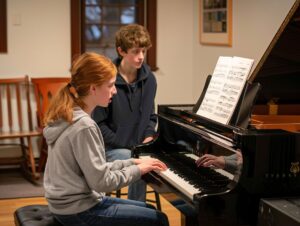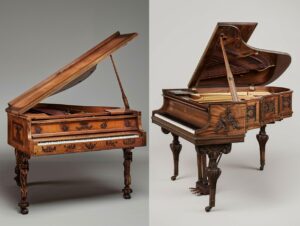Are you torn between learning the piano or the violin?
Both instruments have a rich history and unique characteristics that make them a popular choice among music enthusiasts.
We will explore the similarities and differences between the piano and violin, from their shared features to the distinct sound production and playing techniques.
Discover which instrument might be the right fit for you, considering factors like learning challenges and benefits.
Whether you’re drawn to the grandeur of the piano or the elegance of the violin, read on to learn more about these timeless musical instruments.
| Aspect |
Piano |
Violin |
| History and Evolution |
Gained popularity during the Classical era |
Prominent since the Baroque period |
| Sound Production |
Sound produced by hammers striking strings |
Sound produced by bowing or plucking strings |
| Techniques |
Key strikes and pedal manipulation |
Bowing techniques and precise hand positioning |
| Playing Posture |
Seated, hands on keyboard |
Standing or sitting, instrument on collarbone |
| Physical Structure |
Keyboard layout |
String-based pitch production |
| Sound Characteristics |
Wide dynamic range, can be both delicate and powerful |
Warm, expressive, and intimate sound |
| Learning Curve |
Easier to learn initially |
Requires precise intonation and bowing control |
| Finger Dexterity |
Finger placement on keys |
Finger placement on fingerboard |
| Hand Coordination |
Requires coordination between both hands |
Requires coordination between both hands and bow |
| Reading Music |
Multiple clefs, complex compositions |
Primarily treble clef, focus on intonation |
| Learning Challenges |
Developing hand coordination and finger strength |
Achieving accurate intonation and bow control |
| Versatility |
Solo and accompaniment versatility |
Blends well in ensembles, solo performance |
| Common Genres |
Classical, jazz, pop, contemporary |
Classical, folk, jazz, pop |
| Famous Composers |
Mozart, Beethoven, Chopin |
Vivaldi, Bach, Tchaikovsky |
| Physical Demand |
Less physical strength required initially |
Requires more strength and coordination initially |
| Maintenance |
Regular tuning, generally less maintenance |
Regular tuning, string replacement, bow care |
| Pedagogical Methods |
Emphasis on finger placement and musical theory |
Emphasis on ear training and bowing techniques |
| Instrument Cost |
Varies widely, generally more expensive |
Varies widely, generally less expensive |
| Space Requirement |
Requires more space |
More portable, requires less space |
| Popularity |
Widely popular, suitable for all ages |
Popular in classical and folk music, also suitable for all ages |
Brief History and Evolution

The history and evolution of the violin and piano are deeply intertwined with the development of classical music throughout centuries. From the classical periods to the romantic eras, both instruments have held significant importance in shaping the musical landscape.
During the Baroque period, the violin emerged as a prominent solo instrument, demonstrating its agility and expressive capabilities through works by renowned composers such as Vivaldi and Bach. Simultaneously, the piano, known for its versatility and wide dynamic range, gained popularity during the Classical era, enriching the compositions of celebrated musicians like Mozart and Beethoven.
In the 19th century, the Romantic period witnessed composers like Chopin and Tchaikovsky harnessing the emotive power of both the violin and piano. Their works were characterized by intense emotion and introspection, leaving a lasting impact on audiences worldwide.
Similarities between Piano and Violin
The piano and the violin, while differing in their physical attributes, share similarities in their capacity to generate harmonious sounds that resonate with listeners. Both instruments necessitate meticulous techniques and expertise to effectively communicate the composer’s desired emotions.
Shared Characteristics and Features
The similarities between piano and violin encompass the necessity of proficient finger dexterity to execute accurate notes, the significance of hand-eye coordination, and the precise techniques required to deliver precise and emotive musical renditions.
In both piano and violin playing, the fingers serve as the primary tools for interacting with the instrument and translating musical concepts into audible melodies. Whether it pertains to the intricate finger placements on piano keys or the swift movements across the fingerboard of a violin, precision stands as a fundamental requirement.
Acquiring mastery over the hand positions specific to each instrument is imperative for attaining fluidity and seamless transitions between notes. The synchronization between fingers and hands plays a crucial role in controlling dynamics, articulation, and phrasing in performances involving both the piano and violin.
Differences between Piano and Violin
Although piano and violin exhibit similarities, they markedly differ in their physical structures and playing methodologies. The keyboard layout of the piano contrasts with the string-based pitch production of the violin, resulting in unique approaches to musical expression and performance.
Sound Production and Techniques
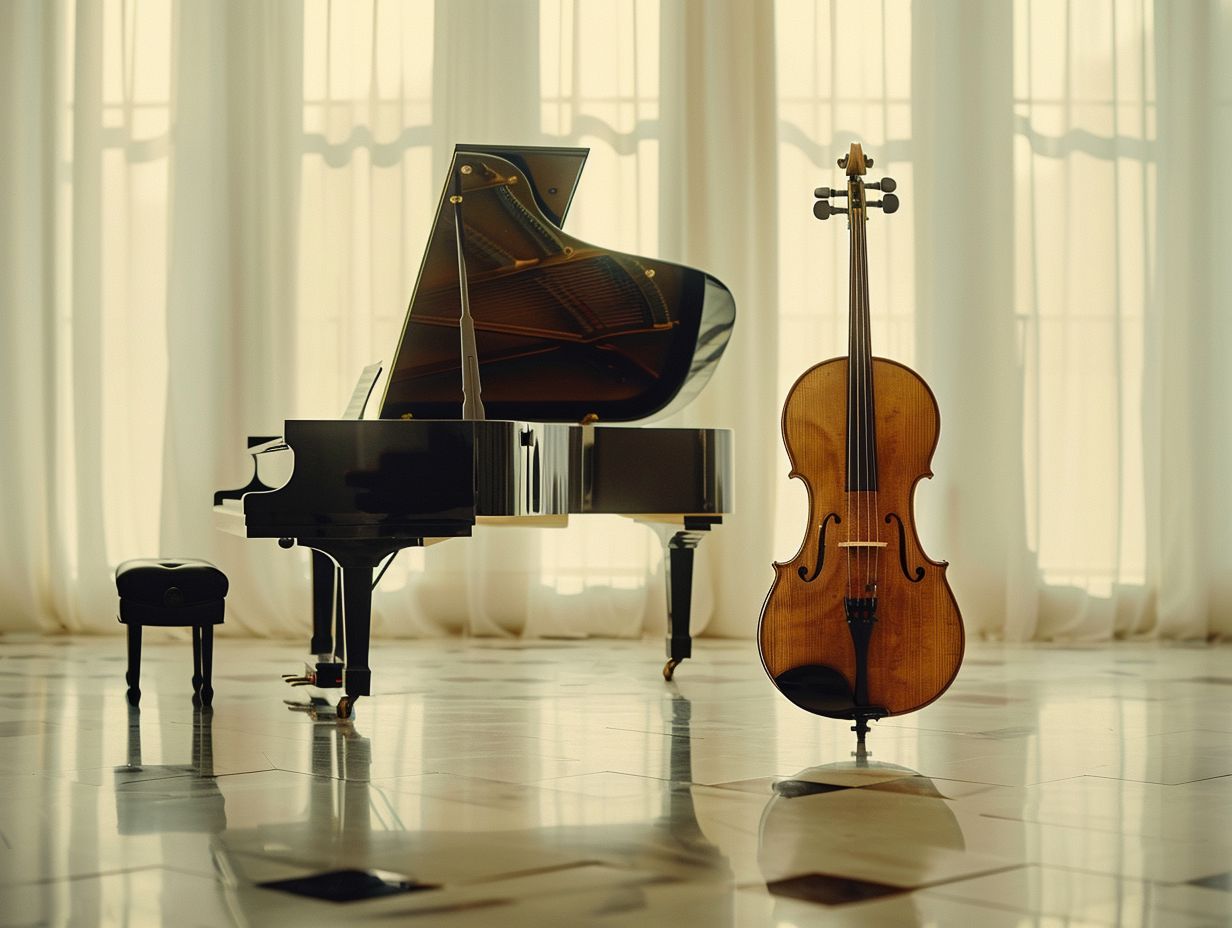
The production techniques of the violin and piano exhibit notable distinctions, as the violin primarily relies on bowing techniques to intricately shape the tonal nuances, whereas the piano employs a blend of key strikes and pedal manipulation to modulate the quality of sound. The Suzuki method presents a distinct pedagogical approach towards mastering both these musical instruments.
In the realm of violin performance, the precise tuning of each string and the meticulous hand positioning play pivotal roles in achieving a refined and resonant sound quality. Conversely, pianists concentrate on finger placement and pressure to elicit a diverse and dynamic range of tones.
The auditory characteristics of the violin are often characterized as warm and expressive, while the piano’s timbre can span from delicate and intimate to robust and grandiose. A thorough understanding of these distinctions can augment a musician’s capacity to interpret a wide array of musical compositions with profundity and emotional resonance.
Physical Differences and Playing Styles
The distinctions in physical requirements between playing the violin and piano encompass aspects such as posture, hand positioning, and overall physicality. Violinists specifically focus on executing precise bowing techniques and hand placements, whereas pianists must navigate intricate fingerings and postures to achieve optimal playing comfort and technique.
When performing on the violin, a musician must maintain an erect posture with the instrument positioned on their collarbone and chin, necessitating a steady control and balance. Conversely, a pianist is seated at the keyboard, utilizing both hands to strike various keys and employing sophisticated finger movements to produce a broad range of tones.
The left hand of the violinist is responsible for accurately pressing the strings on the fingerboard, while the right hand controls the bow’s pressure and speed to create diverse dynamics and timbres.
Which Instrument is Right for You?
The selection between the violin and piano is contingent upon individual preferences, musical aspirations, and comfort levels with the physical demands of each instrument. It is advisable to take into account your learning style, preferred musical genres, and the playability of the instrument in order to ascertain which choice is most consistent with your musical aspirations.
Factors to Consider
When faced with the decision of selecting between learning the violin or piano, individuals should carefully consider the challenges inherent in each musical instrument. Seeking guidance from experienced instructors and assessing their commitment to mastering the technical and musical intricacies associated with either option is paramount.
Both the violin and piano pose distinctive challenges that necessitate unwavering dedication to cultivate proficiency. Opting for the violin calls for a discerning ear for intonation and bow technique, whereas the piano requires adept hand coordination and a comprehensive understanding of complex musical compositions.
Additionally, students should take into account the availability of proficient instructors who can offer personalized instruction to help navigate these challenges effectively. Consistent practice and patience serve as pivotal elements in making progress with either instrument, underscoring the significance of resolute commitment in refining one’s musical abilities.
Learning Piano vs Violin
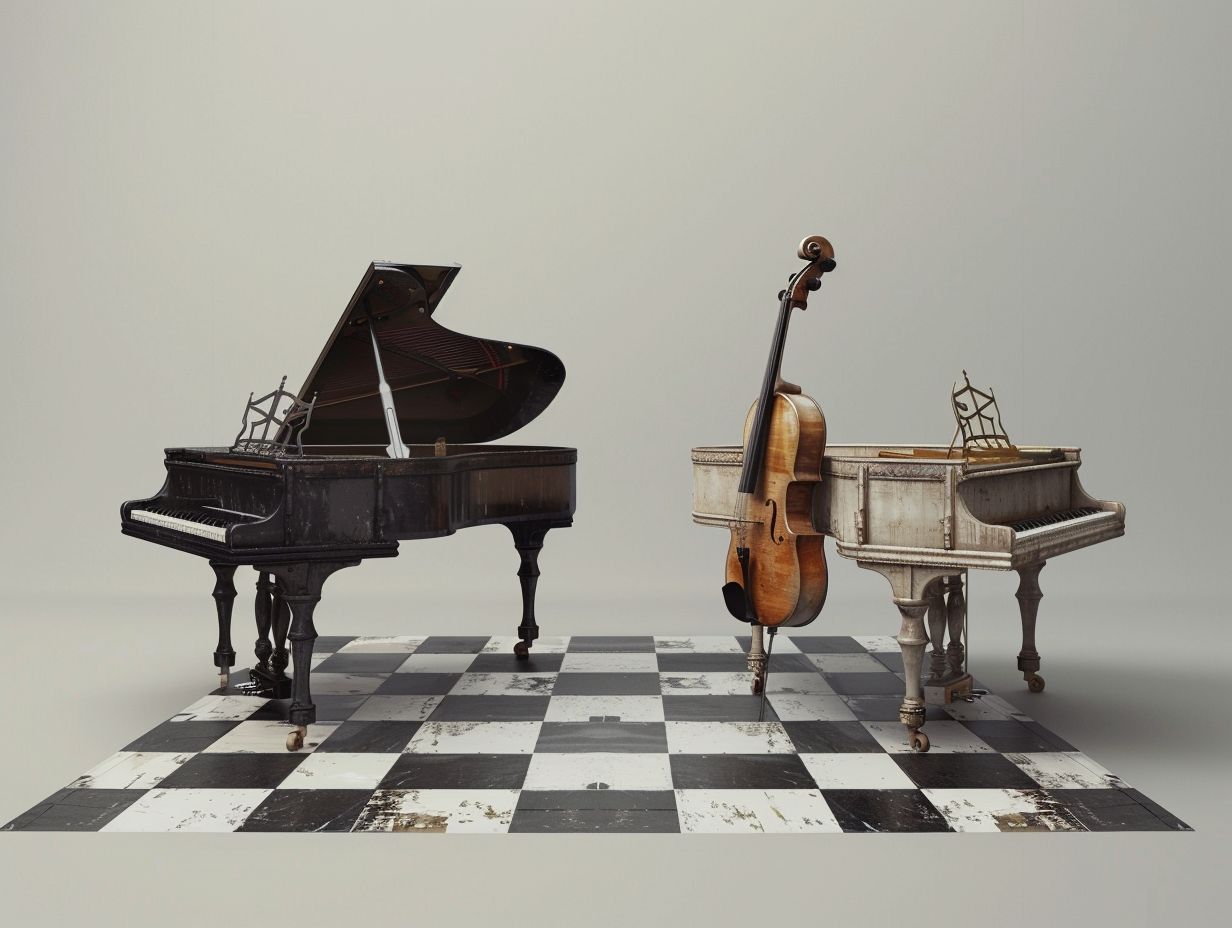
Embarking on the pursuit of learning the piano or violin entails acquiring fundamental skills, diving into various pedagogical approaches, and comprehending the importance of posture in cultivating optimal playing techniques. Each instrument presents distinctive challenges and rewards for committed students.
Challenges and Benefits of Each Instrument
Mastering the violin or piano presents distinctive challenges and advantages to students, involving the refinement of intricate finger techniques and the visual interpretation of musical notes. Both instruments offer a fulfilling journey of musical exploration and personal development for committed learners.
Proficiency in playing the violin necessitates a precise sense of pitch accuracy and skilled bowing control, whereas mastering the piano entails the cultivation of manual dexterity and coordination between both hands. While note reading is a fundamental skill for both instruments, learning multiple clefs is a more intricate task specific to the violin.
The visual analysis of musical scores plays a pivotal role in comprehending aspects such as phrasing, dynamics, and tempo, assisting musicians in effectively conveying emotions through their performances.
Frequently Asked Questions
1. What are the main differences between playing the piano and the violin?
The biggest difference between playing the piano and the violin is the physical technique required. The piano is played by pressing keys with your fingers, while the violin is played by drawing a bow across strings. Additionally, the piano produces sound through hammers hitting strings, while the violin produces sound through vibrations of the strings.
2. Which instrument is easier to learn, piano or violin?
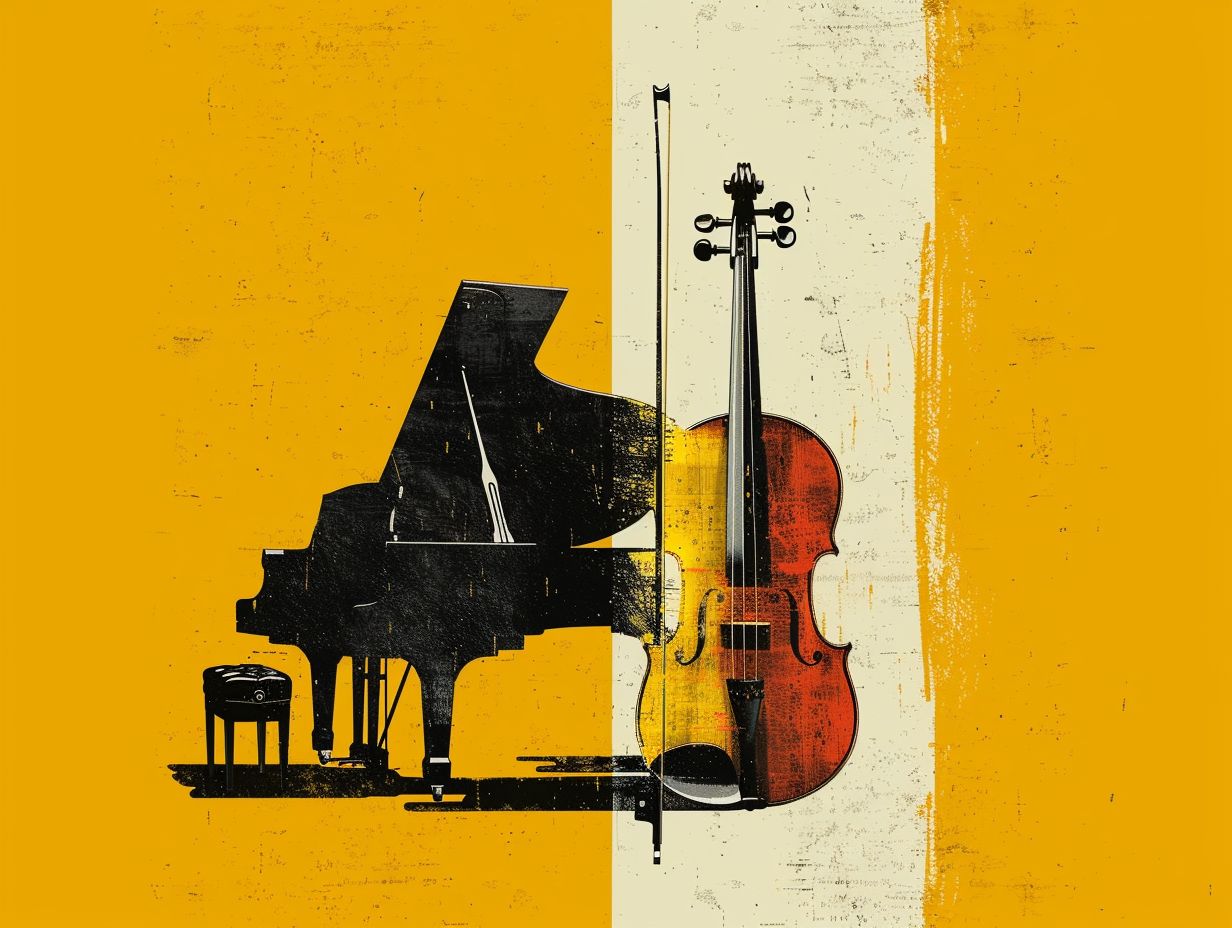
This is a subjective question as difficulty can vary from person to person. However, many people find the piano to be easier to learn initially because it is more intuitive and does not require as much strength and coordination as the violin. However, both instruments require practice and dedication to master.
3. Can you play the same music on piano and violin?
Yes, many pieces of music are written for both piano and violin. However, the sound and interpretation may differ due to the nature of the instruments. The piano is capable of playing chords and multiple notes at once, while the violin is limited to playing one note at a time. Additionally, the tone and expression produced by each instrument may differ.
4. Which instrument is more versatile, piano or violin?
Both the piano and the violin are versatile instruments, but in different ways. The piano is often seen as a versatile solo and accompaniment instrument, while the violin is known for its ability to blend with other instruments in an ensemble setting. However, both instruments can be used in various genres of music and have a wide range of techniques and playing styles.
5. Do piano and violin use the same musical notation?
Yes, both instruments use the same musical notation system. This means that the same notes, rests, and symbols are used to notate music for both piano and violin. However, the way these notations are interpreted may differ slightly due to the technical differences between the two instruments.
6. How do I choose between learning piano or violin?
Ultimately, the decision between learning piano or violin should be based on your personal interests and preferences. Consider the sound and style of music you enjoy, as well as the physical demands and technical abilities required for each instrument. It may also be helpful to try both instruments before making a decision.
